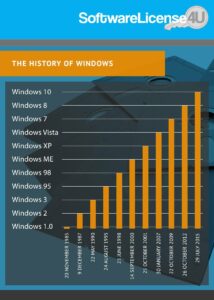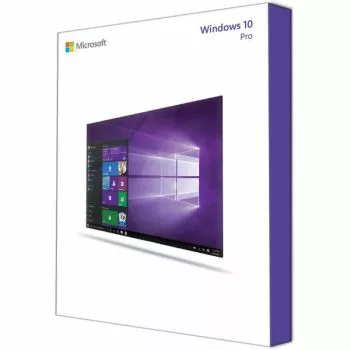THE HISTORY OF WINDOWS: FROM WINDOWS 1.0 TO WINDOWS 10
The first Microsoft Windows operating system was released in 1985. Now we are almost 30 years, and many Windows versions, further. Almost every 3 years Microsoft released a new Windows version. It is almost hard to imagine that de old-fashioned Windows 1.0 was the predecessor of the hypermodern Windows 10. Learn in this blog how Windows is perfectioned and is evolved to the most used operating system in the world.
Windows 1.0
In November 1985 Windows 1.0 was presented to the public. According to the CEO of Microsoft, Bill Gates, Windows 1.0 was a unique operating system developed for heavy PC-users. It was the first operating system where the mouse was often used. In previous operating systems, the mouse was hardly used and users had to rely on the keyboard more often to perform certain actions.
The first version of Windows contained different applications, such as the graphics program Windows Paint. Also apps such as Windows Write, a calendar and Notepad were added. To let users get accustomed to the mouse a computer game was added, called Reversi. PC-users could play this game my moving the mouse across the playboard on the screen.
To be fair, Windows 1.0 can’t be seen as a complete operating system. The software should be seen more as an add-on of MS-DOS. This means that Windows 1.0 also shared some (major) flaws with MS-DOS. This is the main reason this operating system was not widely used by PC-users. Fun fact: the first idea was to release Windows 1.0 under the name ‘Interface Manager’.
Windows 2
On 9 December 1987 the successor of Windows 1.0 was released to the market. Windows 2 was a bit more popular than the previous version. This was mainly due to several improvements that were added. For instance, the graphical interface was greatly improved. Furthermore, different programs could ‘overlap’ each other on the screen.
Also the option to minimize and maximize applications was introduced in Windows 2. Lastly, two ‘brand new’ applications where standard installed in this newest Windows-build: Excel and Word for Windows.

Windows 3
Windows 3 was announced by Microsoft on May 22, 1990. Especially the speed was significantly improved in the Windows version. This was mainly due to the introduction of the ‘Protected Modus’. Because of this, Windows 3 gained access to specific parts of the memory, which resulted in applications that could use more megabytes from the memory. Furthermore the system supported the use of 256 different colors. This gave Windows 3 a fresh and modern look.
In the Windows 3.1 updates the world-famous game Minesweeper introduced. Moreover, this was the first Windows version ever that was sold on CD-ROM. In total more than 10 million copies were sold of this Windows operating system.
Windows 95
Windows 95 was released in, such as the name suggests, 1995. Two iconic elements where introduced in this operating system: the Start Menu and the Taskbar. This also was the first Windows operating system that had access to the internet. Also, external devices such as a mouse and keyboard could be easily connected thanks to the new ‘plug-and-play’ principle. Furthermore, 32 bit-programs where supported in this new operating system. A stunning 7 million copies of Windows 95 were sold worldwide in the first 5 weeks after the release.
Windows 98
Three years later, in June 1998, Windows 98 was introduced by Microsoft. Not many revolutionary adjustments were introduced in this operating system. That also might be the reason Windows 98 was not sold that much. A huge improvement though, was the support for USB-equipment. Because of this, USB-devices were much easier to use by PC-users. Also certain much used applications were introduced in this version such as Internet Explorer and Outlook Express. Another improvement was the introduction of the two navigational buttons ‘back’ and ‘forward’.
Windows ME & 2000
According to most people the, in September 2000 released operating system Windows ME was a complete disaster. The operating system was mainly knows for its instability, installation problems and buggy features. Hardly any improvements were made since the previous build. This was the last Windows operating systems that was based on the old-fashions MS-DOS. Different new applications such as Windows Media Player and Windows Movie maker were added to Windows ME.
Windows 2000 can be seen as the business version of this operating system. In Windows 2000 the System Restore-function was introduced. Rebooting the computer was also not necessary anymore after changes in the Windows configuration were made. This, in contradiction to all previous Windows builds.
Windows XP
One of the most iconic and revolutionary operating systems ever was introduced in October 2001. Windows XP is still seen by many people as the best operating system ever by many people. Windows XP was completely aimed at the ‘normal’ PC user. This translated itself into a very stable and user-friendly operating system with a modern and beautiful design.
For instance, the interface was available in three different colors: olive, blue and silver. In Windows XP USB 2.0 support was added, Furthermore .NET, IPv6 and SATA-hard disks bigger than 137 GB were supported in Windows XP. Lastly, Windows XP introduced the warning that a file ‘might’ contain a virus when computer-users open a downloaded file.

Until now Windows XP is the second most sold operating system of Microsoft, slightly behind Windows 7. A negative point of Windows XP had something to do with the security. It was relatively easy for hackers the breach the firewall and to get access to private files. This made Windows XP-computers a beloved target for internet criminals.
Windows Vista
Windows Vista was released in 2007 by Microsoft. A remarkable adjustment was the introduction of the Windows Aero theme. Transparent elements with a modern look where added in this improved interface.
Windows Vista was not welcomed with open arms by the public. Main reason were the system requirements of this operating system. The operating system demanded much more power than Windows XP. On many computers Windows Vista functioned buggy or not at all. However, one certain group was very pleased with Windows Vista: gamers. This was mainly due to the introduction of DirectX 10.
Windows 7
Windows 7 was the long-waited successor of Windows Vista. The operating system was release by Microsoft in October 2009. Microsoft had the goal to remove all problems PC-users had with Windows Vista by releasing Windows 7. They gloriously succeeded with the release of this new operating system. Windows 7 was a received very well by PC-users.
One improvement was the renewed Taskbar, with bigger icons and a modern look. Also the interface of the Windows Aero theme was greatly improved. Altogether this resulted in fewer bugs and a more user-friendly and stable operating system. Furthermore, facial recognition was introduced in Windows 7.
Windows 8.0 & Windows 8.1
Windows 8.0 is one of the most recent operating systems by Microsoft and was released in October 2012. Windows 8.0 can be seen as an attempt by Microsoft to create a ‘hybrid’ operating system that functions the same on tablets, smartphones and computers. This rigorous change was not so popular by the bigger public.
A major adjustment was the completely redesigned user-interface. For example, within this Metro-theme the Start Menu and Start Button where removed. Furthermore ‘tiles’ and ‘widgets’ were introduced in Windows 8.0 Thanks to this users should get easier access to all installed applications. This re-design received a ton of criticism. Mainly because Windows 8 seemed to be optimized for touchscreens. Most computer-users however simply used a mouse and keyboard. This made Windows 8 not so user-friendly.
Windows 8 was much faster than previous operating systems by Microsoft. This was mainly due to the possibility to use USB 3.0-devices. Major improvements were released with the update of Windows 8.1. The most important one was the ‘reintegration’ of the Start Menu and Start Button. This significantly improved the user-friendliness for PC-users. The Windows 8.1 update was available (free) in the Windows Store since October 2013.
Windows 10
Windows 10 is the newest operating system by Microsoft. The software was released in 28 July 2015. In Windows 10 the Start Menu and Start Button ‘officially’ was reintegrated within the operating system. Another interesting new feature was the possibility to switch between computer and tablet mode. This is mainly useful for computers that work with a detachable keyboard and/or touchscreen. With Windows 10 Microsoft tries to give users of all Windows-machines ‘one universal operating system’ to improve the user-friendliness.

There is a big chance that this will be the last Windows operating system by Microsoft. Microsoft realized that people don’t want to adapt to a new operating system every couple of years. They stated that they want to focus on ‘updating’ their newest operating system instead of ‘redeveloping’ it all the time.
The rich history of Windows
In this article it became clear that the Windows operating systems by Microsoft changed significantly in the past 30 years. From the plain and simple Windows 1.0 you can now use the modern and user-friendly Windows 10: the most used operating system in the world. Do you also want to work with the newest Windows operating system? Then quickly check out the original and cheap Windows 10 licenses by SoftwareLicense4U! All licenses are delivered within 5 minutes via e-mail.

